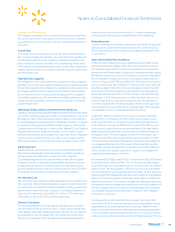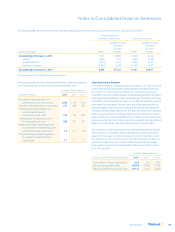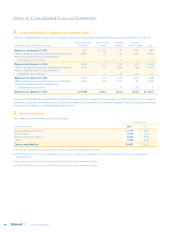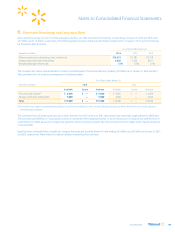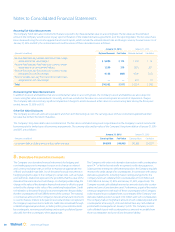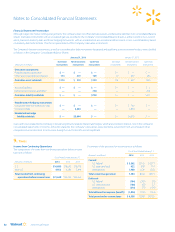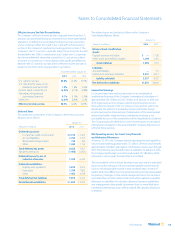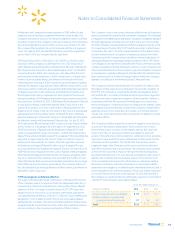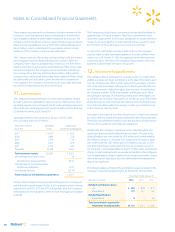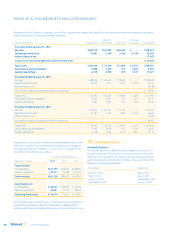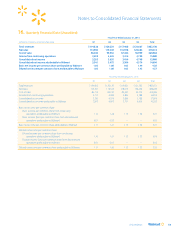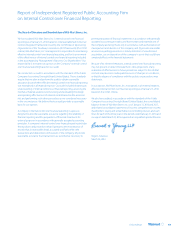Walmart 2016 Annual Report Download - page 55
Download and view the complete annual report
Please find page 55 of the 2016 Walmart annual report below. You can navigate through the pages in the report by either clicking on the pages listed below, or by using the keyword search tool below to find specific information within the annual report.
53Only Walmart
Effective Income Tax Rate Reconciliation
The Company’s effective income tax rate is typically lower than the U.S.
statutory tax rate primarily because of benefits from lower-taxed global
operations, including the use of global funding structures and certain
U.S. tax credits as further discussed in the “Cash and Cash Equivalents”
section of the Company’s significant accounting policies in Note 1. The
Company’s non-U.S. income is generally subject to local country tax rates
that are below the 35% U.S. statutory tax rate. Certain non-U.S. earnings
have been indefinitely reinvested outside the U.S. and are not subject
to current U.S. income tax. A reconciliation of the significant differences
between the U.S. statutory tax rate and the effective income tax rate on
pretax income from continuing operations is as follows:
Fiscal Years Ended January 31,
2016 2015 2014
U.S. statutory tax rate 35.0% 35.0% 35.0%
U.S. state income taxes, net of
federal income tax benefit 1.8% 1.8% 2.0%
Income taxed outside the U.S. (4.0)% (2.7)% (2.8)%
Net impact of repatriated
international earnings 0.1% (1.5)% (1.4)%
Other, net (2.6)% (0.4)% 0.1%
Effective income tax rate 30.3% 32.2% 32.9%
Deferred Taxes
The significant components of the Company’s deferred tax account
balances are as follows:
January 31,
(Amounts in millions) 2016 2015
Deferred tax assets:
Loss and tax credit carryforwards $ 3,313 $ 3,255
Accrued liabilities 3,763 3,395
Share-based compensation 192 184
Other 1,390 1,119
Total deferred tax assets 8,658 7,953
Valuation allowances (1,456) (1,504)
Deferred tax assets, net of
valuation allowance 7,202 6,449
Deferred tax liabilities:
Property and equipment 5,813 5,972
Inventories 1,790 1,825
Other 1,452 1,618
Total deferred tax liabilities 9,055 9,415
Net deferred tax liabilities $ 1,853 $ 2,966
The deferred taxes are classified as follows in the Company’s
Consolidated Balance Sheets:
January 31,
(Amounts in millions) 2016 2015
Balance Sheet classification:
Assets:
Prepaid expenses and other $ — $ 728
Other assets and deferred charges 1,504 1,033
Asset subtotals 1,504 1,761
Liabilities:
Accrued liabilities — 56
Deferred income taxes and other 3,357 4,671
Liability subtotals 3,357 4,727
Net deferred tax liabilities $1,853 $2,966
Unremitted Earnings
U.S. income taxes have not been provided on accumulated but
undistributed earnings of the Company’s international subsidiaries of
approximately $26.1 billion and $23.3 billion as of January 31, 2016 and
2015, respectively, as the Company intends to permanently reinvest
these amounts outside of the U.S. However, if any portion were to be
distributed, the related U.S. tax liability may be reduced by foreign
income taxes paid on those earnings. Determination of the unrecognized
deferred tax liability related to these undistributed earnings is not
practicable because of the complexities with its hypothetical calculation.
The Company provides deferred or current income taxes on earnings of
international subsidiaries in the period that the Company determines it
will remit those earnings.
Net Operating Losses, Tax Credit Carryforwards
and Valuation Allowances
At January 31, 2016, the Company had net operating loss and capital loss
carryforwards totaling approximately $5.3 billion. Of these carryforwards,
approximately $3.0 billion will expire, if not utilized, in various years through
2036. The remaining carryforwards have no expiration. At January 31, 2016,
the Company had foreign tax credit carryforwards of $1.8 billion, which
will expire in various years through 2026, if not utilized.
The recoverability of these future tax deductions and credits is evaluated
by assessing the adequacy of future expected taxable income from all
sources, including taxable income in prior carryback years, reversal of
taxable temporary differences, forecasted operating earnings and available
tax planning strategies. To the extent management does not consider it
more likely than not that a deferred tax asset will be realized, a valuation
allowance is established. If a valuation allowance has been established
and management subsequently determines that it is more likely than
not that the deferred tax assets will be realized, the valuation allowance
is released.
Notes to Consolidated Financial Statements


